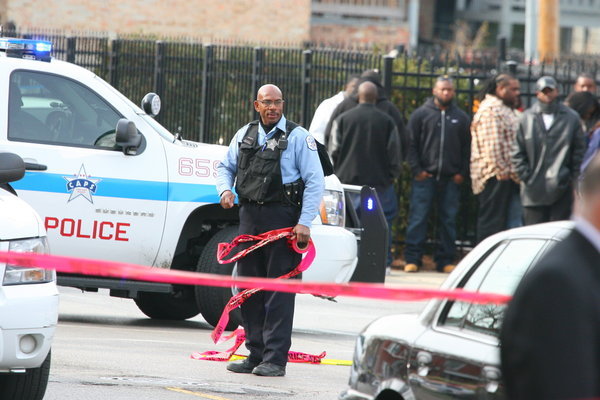
Slammed today from catching up on the future of data and… print duties. With that, a roundup of excellent things written recently about violence, gangs, and Chicago, a good introduction if you're virtually visiting from out of town:
* First, Alex Kotlowitz—whose There Are No Children Here is 21 years old—with the keynote piece in Time Out Chicago's "Stop the Killing" issue:
I recently met one high-school student, Thomas, who rattled off for his social worker the people he’s seen shot. The first was at a birthday party for a friend who was turning 11. She was shot and killed when a stray bullet struck her in the head. Then Thomas saw his brother shot, on two occasions, the second time paralyzing him. He saw a friend shot while waiting at the bus stop. And then this past summer as Thomas chatted on a porch with a fellow student, a boy with a gun approached. Thomas begged him not to shoot, but he ignored the pleas, and Thomas’s 16-year-old friend was shot three times in her torso. She died on the porch. After this last incident (incident seems completely inadequate for such bloodshed), Thomas retreated into himself, pulling inward, unwilling, unable to acknowledge his grief. He could only manage to tell his social worker, “I want to hurt someone. I want to hurt someone.” It was the only way he could articulate the pain.
Kotlowitz joined up with WBEZ's veteran reporter Linda Lutton on a This American Life series about Chicago's Harper High, which begins tonight, the result of a semester's worth of full-access reporting.
* Ta-Nehisi Coates, who grew up on Baltimore's west side in the 1980s and 1990s, talks with the University of Chicago's Harold Pollack on why Chicago has such problems with crime, particularly homicide (and how they're not unique to Chicago). I was heartened to see that Coates is reading Arnold R. Hirsch's classic Making the Second Ghetto and that he brought it up with Pollack:
Two other issues deserve mention. Failed national housing policies have really hammered Cook County's African-American communities. The same heavily-segregated African-American communities that top the homicide statistics dominate the list of communities checker-boarded with foreclosed or abandoned properties. It's hard to stabilize a community to address crime when this is the economic reality. I myself live in a predominantly African-American neighborhood within the south suburbs. Many houses on our neighborhood stand empty or are in various stages of foreclosure. It wouldn't surprise me if median household wealth among African Americans here has gone negative.
I've been thinking further about Chicago's gang-member density—"You can’t grow up in certain neighborhoods and not be affiliated, because of geography or lineage… it’s often safer to belong than not to belong," Kotlowitz writes—and its causes. It's a mystery, and many causes have been cited, poverty and segregation among them. But I can't help but wonder if one factor is location. Chicago is a major transportation hub, arguably America's biggest and most important; lots of goods flow through the city. Licit and illicit goods usually follow the same pathways, for the same reasons; economic organizations build up around those, and that's an aspect of what gangs are, though not the only one. (If you want an old long read on Chicago violence and gangs, the University of Chicago Press is re-releasing Frederic Thrasher's 1927 study The Gang next month.)
* Speaking of which, Mick Dumke has an amazing long read on the anatomy of a heroin ring for the Reader:
The slaying outside the McDonald's would remain one of the open cases. What led to the gunfire—and how it was connected to a string of other violent acts around the city—wouldn't become evident for another two years, after an investigation led deep into a highly profitable heroin ring on the west side that employed dozens of residents, served thousands of customers from around the midwest, and had ties to Mexican drug cartels.
What turned out to be most notable about the operation, though, was how typical it was. The DEA estimates that 80 percent of the heroin and cocaine sold in Chicago originates with the Sinaloa cartel in Mexico. Distributors here extend the cartel's reach by connecting with street gangs. The gangs, in turn, hasten the decline of distressed communities into open-air drug markets through their skillful use of product promotion, their ability to offer job opportunities where there are few, and their willingness, when necessary, to use violence to stay in business.
* Steve Bogira, who, like Kotlowitz, has been covering these issues for decades in Chicago, on the speech Obama should give:
To address concentrated poverty today, we must proceed on two fronts. First, we must spend much more on programs that we know help the residents of such neighborhoods—on prenatal care, parenting programs, early childhood education, schools, job training. I have already advocated for such spending, to create ladders of opportunity for the poor, but my proposals have been too modest.
* And while not about Chicago, but very much related to Bogira's piece, Detroit-raised historian Thomas Sugrue on housing, segregation, and the destruction of wealth.
Photograph: Chicago Tribune


